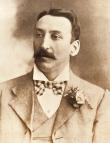In reviewing the 1909 Melbourne premiere, the Age records that this version of The Babes in the Wood had 'a decidedly Australian flavour' (28 December 1909, p.6). The chief characters include the two children, Jack (the miller's son), Maria (the children's governess), the two robbers (described as 'a robber bold and a robber bolder'), Baron Steakanchips, Phyllis (the baron's daughter), the Demon King, and Titania (the Fairy Queen). The cast, as advertised in the West Australian, included some 250 people, playing such characters as goblins, fairies, bathers, sailors, imps, demons, birds, huntsmen, sprites, will-o-the-wisps, and giants.
The Argus also reports that the prologue, 'a story in itself', takes place in
'a veritable palace of mammoth toys, in which soldiers, teddy bears, Noah's Arks, golly-wogs and storybooks figure prominently. Santa Claus [also] arrives in his aeroplane amongst the wondering youngsters who are thinking out the pantomime they would like. The magic book opens and shows them successively Cinderella, Little Red Riding Hood, Sinbad and last, The Babes in the Wood, which the youngsters acclaim with glee in a song and dance "The Baby Park Parade." The pantomime proper then begins in the icy regions around the North Pole where the Demon King lives' (28 December 1909, p.7).
Songs known to have been incorporated into the narrative included 'Australia's Got a Navy of Her Own', 'Ship Ahoy', 'The Silvery Moon', and 'Banish Sorrow' (sung by Lilian Lea); 'By the Blue Lagoon' (Lilian Lea and Alice Bennetto); 'What, What, What' (James Foreman and Peter Fannan); 'The Grand Hotel', 'Vodka Be Mine', and 'When Mr Poverty Comes Knocking at Your Door' (Nat Clifford); 'Bottle O' and 'Up in an Aeroplane' (Jack Hagan); 'Policeman Moon' (Alice Bennetto); 'Oh Ah Oh Ah' (Nat Clifford and George Dean); and a song sung to the final tableaux, 'Australia's Pride' (James Hughes).
The spectacular highlights of the production are said to have been 'The Baby Park Parade', 'The Fairy Picture Book', 'The Iceberg of the Fairy Queen', 'The Children's Palace of Toys', 'The Big Hat Parade', 'Australia's Navy', 'The Burlesque Fight of the Robbers', and 'Revels at the Seaside.' Miss Margaret Kloss also performed a dance to the ballet 'Vision of Salome Waltz.'
 1249211049142166725.jpg
1249211049142166725.jpg